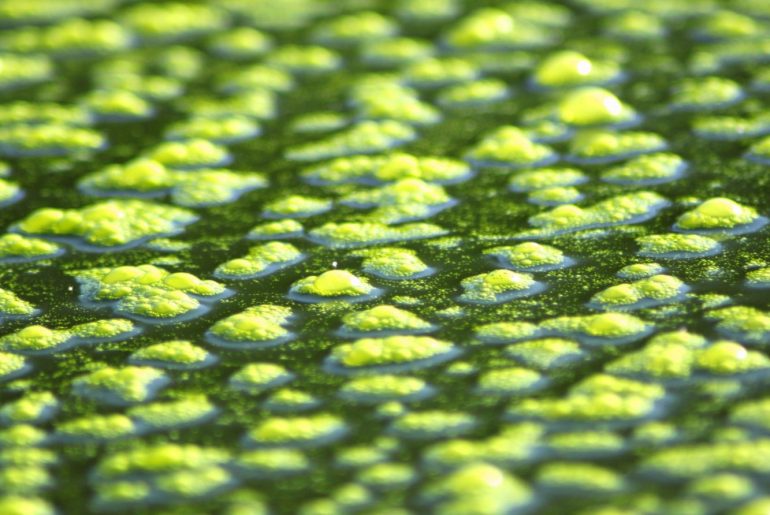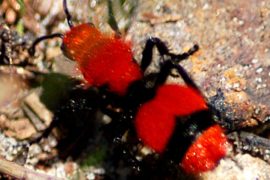Spot algae in the aquarium are among the most common types of algae. They can be seen somewhere in almost every aquarium. Green spot algae are often found on the aquarium pane, on decorative objects or on slow-growing aquarium plants. You can read the most important questions and answers about spot algae in the aquarium in this article.
The dot algae – what is that?
The spot alga is a form of the rather harmless green alga. Here it is assigned to the genus Coleochaete. The dot alga is also called shield alga. In the aquarium it occurs in the form of hard, punctiform deposits. It loves a bright environment and often occurs when CO2 and phosphate levels are low.
Are spot algae harmful to aquarium plants?
A few smaller green dots on the aquarium plants will not harm them. However, if there is an increased occurrence of spot algae, this can have a negative effect on the plants: they receive too little light under the algae layer to thrive. Unfortunately, the punctiform deposits on aquarium plants cannot usually be removed. Carry out the measures below to combat spot algae in good time. In this way, the aquarium plants will not be damaged.
How do I recognize spot algae? How do I distinguish them from other types of algae?
Spot algae can be easily identified by their shape and color. It forms small, solid, hard green spots on the aquarium pane, on objects or on slow-growing plants such as the java fern.
If green spot algae have spread widely in the aquarium, they can cover larger areas. Nevertheless, the dot algae or shield algae can be easily distinguished from other green deposits in the aquarium – these are formed, for example, by other green algae such as dust algae.
Which animals eat spot algae?
Algae eaters in the aquarium do a good job against green algae. In order to combat spot algae, snails in particular are recommended for the aquarium. They tirelessly rattle the spot algae deposits off windows and hardscape. Unfortunately, popular snail species such as the snail or the antler snail prefer soft algae coverings. Since there are usually enough of these in the aquarium, algae eaters are only a limited solution against spot algae because they only eat them last.
What is the trigger for green spot algae in the aquarium?
Green dots on the pane of the aquarium, which only appear sporadically, do not have to have a special cause. On the contrary, they occur even with perfect water parameters. How can that be? As is usually the case with green algae: the cause of spot algae is usually an imbalance in the nutrients in the aquarium. Basically, algae need the same nutrients as aquarium plants. However, they are more undemanding and can tolerate an imbalance much easier. You can find out more about these connections in our article Algae in the aquarium.
Is the spot algae a sign of bad water parameters?
No, quite the opposite: spotted algae tend to indicate good general water values - in contrast to other types of algae, such as blue-green algae or diatoms, which can be a sign of poor water quality.
Remove spot algae – step by step
- Identify the alga. Is it really spot algae, or is there another green alga?
- Remove annoying green algae deposits on the aquarium pane with a blade. Razor blade holders do an excellent job at this.
- Go in search of the causes of the formation of the algae. Test water parameters such as phosphate and nitrate. Check whether the environmental parameters allow for optimal plant growth.
The most important measures to combat spot algae are:
- manual removal of spot algae
- create optimal water values
- use fast-growing plants
If the aquarium is stocked with fast-growing aquarium plants, the spot algae have strong competition. They should not spread excessively in such a tank. This rule applies in principle to combating algae in the aquarium: the more stable the ecosystem in the aquarium, the fewer chances algae have of spreading.
Our tip against spot algae on slow-growing plants:
Position slow-growing plants in shadier areas.
With these tips and simple measures, you should be able to get the spread of spot algae under control in the long term without any problems. What experiences have you had with spot algae in the aquarium? We appreciate your comments!
What are spot algae?
Aquarists usually refer to green, flat algae coverings that are very firmly attached as spot algae. At the beginning they grow very selectively and look like small round spots. Over time and under the right conditions, spot algae can also spread over a large area.
Which animals eat spot algae?
Which animals eat dust algae, spot algae and other green algae deposits? Course snails, antler snails and other aquarium snails, but also shrimp and growth-eating fish like to feed on the softer green algae coverings. Spot algae, on the other hand, are so hard that they can hardly be eaten.
What types of algae are there in the aquarium?
- Green algae (thread algae, spot algae, floating algae, hair algae, …)
- Red algae (brush algae, beard algae)
- Brown algae (diatoms)
- blue-green algae
What to do against spot algae?
The best way to remove spot algae is with a window cleaner with a blade or with a used plastic card (credit card, customer card or similar). Spot algae are particularly fond of infesting slow-growing plants such as Anubias, but they can also be found on other plants in the event of severe nutrient deficiencies.
Is CO2 good against algae?
And that is exactly why aquarium plants and algae are food competitors. When the plants grow well, the algae have little food left and they take care of themselves. CO2 fertilization promotes the growth of the plants and thus gives the algae no chance!
What Light Kills Algae?
The UV-C lamp kills algae and other organisms in your pond as the radiation is absorbed by the DNA of these organisms. The DNA is destroyed in the process. This radiation is helpful for floating algae, which is otherwise difficult to get rid of.
Which light promotes algae?
There is no light that directly hinders algae growth and at the same time promotes plant growth. Algae can only be killed or severely damaged with hard, direct UV-C radiation.
How long can the light be on in the aquarium?
Basically, a change of 12 hours is the minimum frequency with which the aquarium lighting should be switched. Professional and experienced aquarium owners leave the aquarium lighting on for a maximum of 9-11 hours, usually with a three-hour break at midday.





